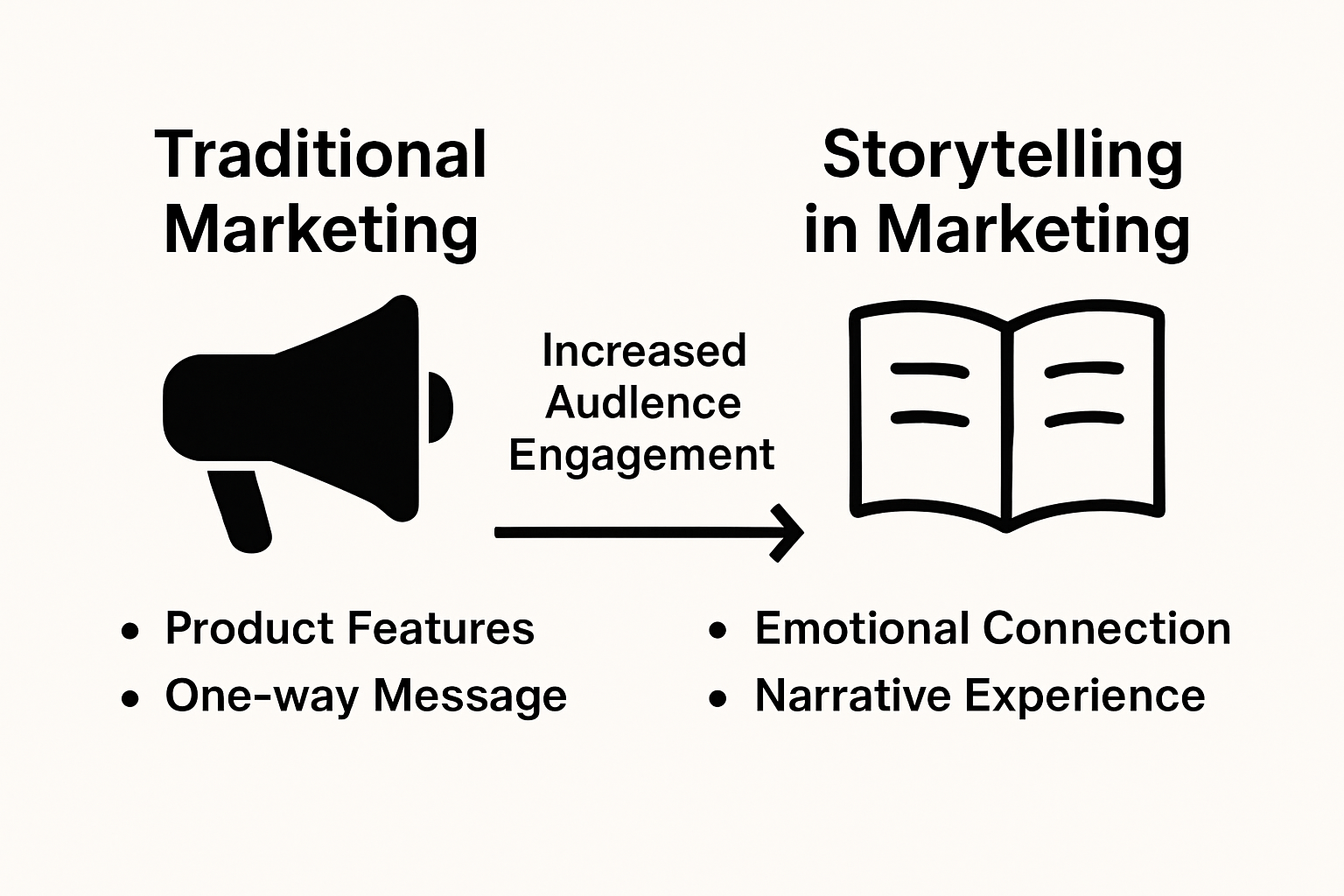Storytelling in marketing is not just about creating catchy ads or clever slogans. Brands that use storytelling are seven times more likely to be remembered than those who only share facts. Most people think choosing the right words or flashy visuals is enough to capture attention, but the real magic happens when brands tap into relatable stories that actually connect with how people think and feel.
Table of Contents
- Defining Storytelling In Marketing: Concepts And Elements
- The Importance Of Storytelling In Marketing: Building Connections
- How Storytelling Works In Marketing: Engaging Audiences
- Key Concepts Of Effective Marketing Stories: Structure And Emotion
- Real-World Examples Of Storytelling In Marketing: Lessons And Insights
Quick Summary
| Takeaway | Explanation |
|---|---|
| Storytelling builds emotional connections | Engaging narratives create trust and relatability between brands and consumers. |
| Effective stories reflect human experiences | Narratives that mirror audience lives foster deeper connections and engagement. |
| Structure your marketing narratives thoughtfully | Clear conflict, character development, and resolution enhance emotional resonance and memorability. |
| Authenticity matters in brand storytelling | Genuine representation of brand values and mission leads to enhanced audience loyalty. |
| Leverage psychological mechanisms for impact | Stories stimulate cognitive engagement and memory retention, making them more effective than traditional advertising. |
Defining Storytelling in Marketing: Concepts and Elements
Storytelling in marketing represents a strategic communication approach where brands craft narrative experiences that connect emotionally with audiences. Unlike traditional advertising methods that focus solely on product features, storytelling transforms marketing messages into compelling journeys that resonate with consumers’ experiences and aspirations.
Core Elements of Marketing Storytelling
At its foundation, storytelling in marketing involves constructing narratives that go beyond simple product promotion. These narratives are carefully designed to engage audiences by creating meaningful connections. Learn more about our narrative marketing approach that transforms communication strategies.

The primary elements of effective marketing storytelling include:
- Character Development: Creating relatable personas that represent target audience challenges and aspirations
- Emotional Resonance: Crafting narratives that trigger genuine emotional responses
- Authentic Messaging: Ensuring stories align with brand values and audience expectations
Understanding Narrative Structure in Marketing
According to research from National Geographic’s storytelling guidelines, successful narratives require strategic planning. Marketing stories must have clear components: a defined starting point, compelling character journey, identifiable conflict or challenge, and a resolution that subtly connects to the brand’s value proposition.
The goal is not merely to sell a product but to create an immersive experience that helps consumers understand how a brand fits into their personal or professional narrative. By focusing on human experiences rather than transactional interactions, brands can build deeper, more meaningful connections with their target audience.
The Importance of Storytelling in Marketing: Building Connections
Storytelling transcends traditional marketing approaches by creating meaningful emotional connections between brands and audiences. This strategic communication method transforms marketing from a transactional interaction into a powerful narrative experience that resonates deeply with consumers.
Emotional Engagement Through Narrative
Emotional connections are the cornerstone of effective marketing storytelling. By crafting narratives that reflect human experiences, brands can develop trust and authenticity. Discover insights into effective brand communication that leverage storytelling techniques to build stronger relationships.
Key psychological mechanisms that storytelling activates include:
Empathy Development: Narratives that mirror audience experiences create immediate emotional connections
Memory Retention: Stories are remembered significantly better than standalone facts
Neural Mirroring: Listeners unconsciously experience similar brain activity to the storyteller
Building Brand Loyalty Through Authentic Narratives
According to research from the AACSB, stories are seven times more likely to be remembered than isolated facts. This phenomenon underscores storytelling’s power in creating lasting brand impressions.
Brands that successfully implement storytelling strategies demonstrate their values, purpose, and human side. By moving beyond product features and showcasing genuine experiences, companies can transform passive consumers into engaged brand advocates who feel personally connected to the organization’s mission and narrative.

How Storytelling Works in Marketing: Engaging Audiences
Storytelling in marketing operates through sophisticated psychological mechanisms that transform communication from mere information transmission to immersive narrative experiences. This approach leverages human cognitive processes to create meaningful connections between brands and audiences.
Cognitive Processing of Narrative Content
Marketing narratives engage audiences by triggering specific neurological responses. When consumers encounter a well-crafted story, their brains activate multiple neural networks simultaneously, processing emotional and rational information concurrently. Explore our insights on audience engagement strategies that highlight the power of narrative communication.
Key cognitive mechanisms in storytelling include:
- Neurological Synchronization: Stories create shared mental experiences between narrator and listener
- Emotional Memory Encoding: Narratives activate limbic systems, making information more memorable
- Pattern Recognition: Human brains naturally seek and understand structured narrative sequences
Psychological Triggers in Marketing Narratives
According to research exploring narrative processing, effective marketing stories activate complex psychological dimensions beyond simple information delivery. These narratives work by creating immersive experiences that resonate with audience emotions, personal experiences, and aspirational thinking.
Successful marketing storytelling transforms brand communication from transactional interactions to meaningful dialogues. By understanding and implementing narrative structures that mirror human communication patterns, brands can create profound connections that transcend traditional advertising approaches, ultimately converting audience attention into genuine engagement and loyalty.
Key Concepts of Effective Marketing Stories: Structure and Emotion
Marketing stories are complex communication tools that blend strategic narrative design with emotional intelligence. They represent more than simple promotional content, functioning as sophisticated psychological bridges between brands and audiences.
Narrative Architecture in Marketing
Effective marketing stories require deliberate structural elements that guide audience engagement. These narratives must balance informational content with emotional resonance, creating compelling experiences that transcend traditional advertising approaches. Discover strategic storytelling techniques that transform brand communication.
Core structural components include:
- Conflict Introduction: Presenting a challenge or problem that resonates with audience experiences
- Character Development: Creating relatable protagonists that embody brand values
- Resolution Pathway: Demonstrating how the brand provides meaningful solutions
Emotional Intelligence in Storytelling
According to psychological research on narrative processing, successful marketing stories activate multiple cognitive and emotional pathways. These narratives are not merely informational transmissions but intricate emotional experiences that connect with audiences on deeper psychological levels.
The most powerful marketing stories transform abstract brand attributes into tangible, memorable human experiences. By understanding and implementing nuanced emotional triggers, brands can create narratives that inspire, motivate, and ultimately drive meaningful audience connections beyond traditional transactional interactions.
Real-World Examples of Storytelling in Marketing: Lessons and Insights
Marketing storytelling transcends theoretical concepts when examined through practical, impactful brand narratives. Real-world examples demonstrate how strategic storytelling can transform audience perception, drive engagement, and create lasting emotional connections.
Narrative Strategies in Brand Communication
Successful marketing stories often leverage universal human experiences to communicate brand values and mission. Explore innovative marketing communication approaches that highlight the power of authentic storytelling.
Key characteristics of compelling brand narratives include:
- Authentic Representation: Stories that genuinely reflect brand identity and values
- Emotional Resonance: Narratives that connect with audience experiences and aspirations
- Memorable Messaging: Communication that transcends traditional promotional content
Learning from Exemplary Marketing Narratives
According to research exploring narrative effectiveness, marketing stories that successfully integrate emotional intelligence can significantly impact brand perception. Brands that craft narratives focusing on human experiences rather than product features create more profound audience connections.
These narratives demonstrate that effective storytelling is not about selling products but about sharing meaningful experiences that reflect shared human values, challenges, and aspirations. By understanding the deeper psychological mechanisms of storytelling, brands can transform their communication from transactional interactions to genuine, inspiring dialogues that resonate with audiences on a fundamental emotional level.
Transform Your Marketing Storytelling Into Real Results With Data-Driven Solutions
Are you finding it challenging to create stories that truly connect and stick in your audience’s mind? Many brands struggle to move from transactional interactions to genuine, memorable engagement. As explored in our article, storytelling that is built on emotional resonance and authentic character can set your brand apart, yet the journey from understanding these concepts to applying them effectively can be tough on your own.
With Zoo Digital, you do not have to guess what works.
- Our agency blends data-driven precision with the strategic art of storytelling so you bridge the gap between narrative theory and measurable growth.
- We help you craft compelling campaigns across Google, Meta and TikTok platforms while making sure your stories are supported by robust tracking and automation.
- Let your marketing evolve from simple communication to a persuasive narrative that boosts engagement and loyalty.

Let your brand’s story drive real change in your results. Visit our main website now to explore how our web development, targeted ads, and automation can turn your story into lasting action. Want to see how narrative marketing works alongside world-class tracking and CRM integration? Learn more about our approach and start building deeper connections with your customers today.
Frequently Asked Questions
What is storytelling in marketing?
Storytelling in marketing is a strategic approach that uses narrative experiences to emotionally connect brands with their audiences, moving beyond traditional product promotion.
What are the core elements of effective marketing storytelling?
The core elements include character development, emotional resonance, and authentic messaging, which work together to create engaging and relatable narratives.
How does storytelling create emotional engagement with audiences?
Storytelling fosters emotional engagement by mirroring audience experiences, helping develop empathy and trust, and enhancing memory retention through memorable narratives.
Why is narrative structure important in marketing?
A clear narrative structure helps convey a coherent message, including character journeys, conflicts, and resolutions, ultimately making brand stories more relatable and memorable.

